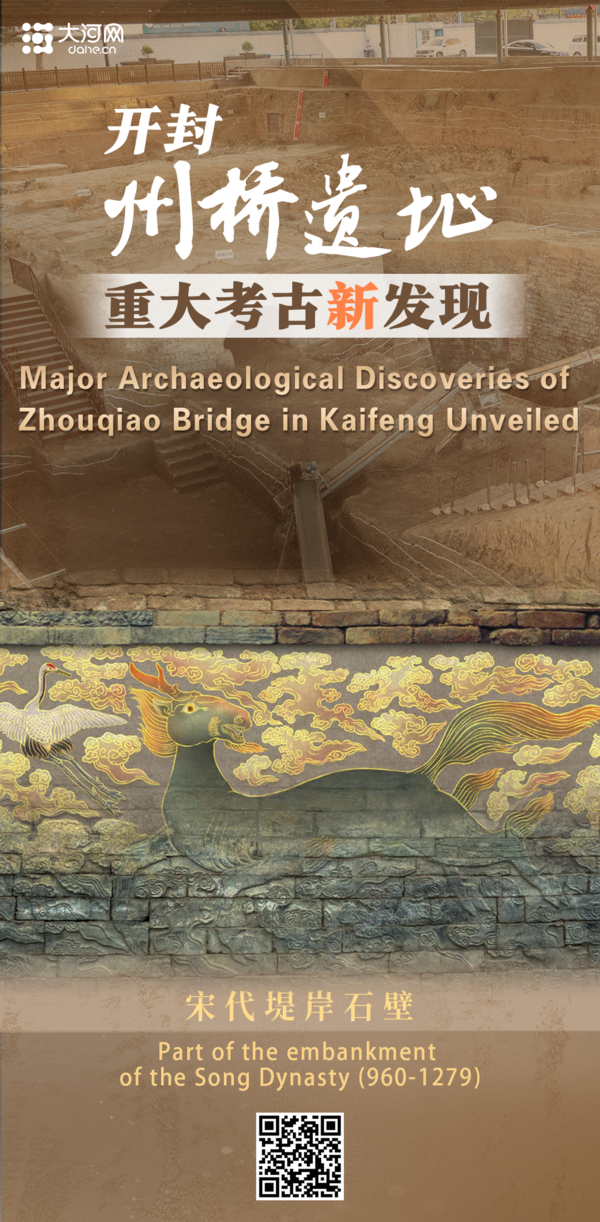Major Archaeological Discoveries of Zhouqiao Bridge in Kaifeng Unveiled
Major Archaeological Discoveries of Zhouqiao Bridge in Kaifeng Unveiled
州桥遗址重大考古新发现:记录开封历史脉络,揭示中原文明进程
On September 28, the National Cultural Heritage Administration announced the major archaeological discoveries of Zhouqiao Bridge in Dongjing (now Kaifeng city of Henan province), the capital of China's Northern Song Dynasty (960-1127), unveiling the historical changes of the urban areas of Kaifeng and the progress of the Chinese nation.
9月28日,国家文物局发布重大考古发现——北宋东京城州桥遗址,再现开封城市历史风貌演变过程,展现中华历史文明进程。

The ruins of Zhouqiao Bridge along the Bianhe River in Kaifeng city. [Photo provided to dahe.cn]
By July 2022, 4,400 square meters of the ruins of Zhouqiao Bridge along the Bianhe River in Kaifeng city have been excavated with 117 remains from different dynasties unearthed, including river course, water conservancy facilities, bridges, roads, temples, houses, sunken ships, wells, storage facilities, cooking benches, ash pits, etc. At the eastern side of the ruins were discovered the course and embankments of the Grand Canal (the Bianhe River section) of the Sui (581-618) and Tang (618-907) dynasties with clear stratigraphic texture. In the river course were also found shipwrecks of the Song Dynasty (960-1279) and timber piles of the Yuan Dynasty (1271-1368). At the western side of the ruins was found a relatively well-preserved Zhouqiao Bridge of the Ming Dynasty (1368-1644) with a bluestone bridge deck, a brick arch and stone abutments. Parts of the embankment of the Song Dynasty have been found to its east on which are reliefs of sea horses, auspicious beasts, cranes and auspicious clouds with an average height of 3.3 meters and a total length of 25 meters. Also, the remains of a river god temple of the late Ming Dynasty, an important part of canal cultural heritage, were discovered around the bridge deck and the river course.
据了解,截止2022年7月,州桥及汴河遗址考古共完成发掘面积4400平方米,发现不同时期各类遗存遗迹117处,种类包括河道、水工设施、桥梁、道路、神庙、房址、沉船、水井、仓储、灶台、灰坑等。其中东侧探方中大运河(汴河)故道遗存河道、堤岸特征明显,地层边界清晰,宋代河道中还发现沉船遗存,元代河道地层中保留有狭河木桩;西侧探方中明代州桥结构基本完整,青石铺筑桥面,砖砌拱券,石砌桥台;桥东侧保留宋代堤岸石壁,石壁上雕镌有海马、瑞兽、鹤禽、祥云浮雕纹饰,纹饰通高约3.3米,总长约25米,构成巨幅长卷。另外在明代州桥桥面与河道中还发现明代晚期金龙四大王庙遗存,与河神祭祀有关,也是重要的运河文化遗产。

Part of the embankment of the Song Dynasty. [Photo provided to dahe.cn]
More than 60 thousand cultural relics have been unearthed from the ruins, including over 56 thousand porcelain wares, 1,800 pottery wares, 1,000 copper coins, 200 bone implements, 100 bronze wares, 50 jade wares, 50 stone tools, 30 iron wares, etc. The blue-and-white porcelain of the Ming Dynasty accounts for the largest proportion of all the porcelain varieties followed by the one with black flowers and white background of the Jin (1115-1234) and Yuan dynasties. Other varieties include white porcelain, bluish-white porcelain and celadon wares printed with decorations of the Song and Jin dynasties, Longquan celadon wares and Jun porcelain of the Jin, Yuan and Ming dynasties, and blue-and-white porcelain, five-color porcelain and famille-rose porcelain of the Ming and Qing (1644-1911) dynasties. Most of them are daily utensils, including bowls, plates, cups, calices, pots, cans, bottles, basins, stationery and toys. Apart from bone implements, a large number of human and animal bones have been found, too. In the flood-caused sediment deposition of the late Ming Dynasty are scattered human bones, while in the normal sediment deposition are animal bones probably thrown away by people at that time. In addition, 3 gilt-bronze statues ranging from 80 cm to 100 cm in height have been discovered near the river god temple, which are extremely rare and precious.
遗址共出土各类文物标本60000多件,质地包括陶、瓷、石、玉、木、骨、金、银、铜、铁、蚌、琉璃等,其中瓷器标本56000多件,陶器标本1800多件,铜钱1000多枚,骨器200多件,铜器100多件,玉器50多件,石器50多件,铁器30多件。瓷器标本中明代青花瓷数量最大,金元时期白地黑花次之,其它种类有宋金时期白瓷、青白瓷、印花青瓷,金元明时期龙泉青瓷、钧瓷,明清时期的青花、五彩、粉彩等。器形以生活用具为多,包括碗、盘、杯、盏、罐、壶、瓶、盆以及文房用品、玩具。骨器除了工具,还有大量人骨遗骸及各类动物骨骼,人骨遗骸多散落在明代末期洪水淤积层下,应为明末洪水毁城导致,动物骨骼主要发现于河道淤积层中,应为人们食物残留。另外在州桥东侧河神庙基址旁发现三尊鎏金铜造像,高80厘米—100厘米,初步判断应为河神庙中神祇金龙四大王、文昌帝君、真武帝君造像,三尊造像不可多得,极为珍贵。

One of the three gilt-bronze statues discovered near the river god temple. [Photo provided to dahe.cn]
The findings at the ruins revealed the layout of Kaifeng, the capital of the Northern Song Dynasty, and showed the evolution of Chinese urban civilization.
州桥遗址发掘成果印证了北宋东京城作为大古都城市的布局形制,反映了中华城市文明演进的历史进程。(中文来源/大河网 编译/赵汉青 杨佳欣 海报/赵原歌 何蒙贺 审校/丁岚)

